Task
A Task is synonymous with a survey. A survey is composed of a sequence of questions that you use to collect data or present information. There are 5 types of tasks that a user can create. We will go through each of them below.
Consent
Medable Axon consent is based on Apple's Research Kit Consent process. Research studies that involve human subjects typically require some form of ethics review. Depending on the country, this may be reviewed by an institutional review board (IRB), or by an ethics committee (EC). For some studies, consent may be required to conduct a research study, which means that the researcher must ensure that each participant is fully informed about the nature of the study, and must obtain a signed consent from each participant. Additionally, consent may be required as a condition of app review.
TIP: All consent tasks must include at least one Document Step and MUST end with a Review Consent Step
To create a consent document, first decide how you want to present your consent document. Categorize your content into sections based on what information you present to users. The standard sections in Medable Axon are produced from Apple's Research Kit. The following document sections come standard with Medable Axon and include the animation built into Apple's Research Kit model.
- Overview
- Data gathering
- Privacy
- Data use
- Time commitment
- Surveys
- Tasks
- Withdrawal
In addition to creating the standard consent sections, Medable Axon allows you to create custom document sections if the predefined consent sections above do not adequately cover the sections of your consent document. Let's Begin.
Create Consent
Create Consent Steps:
- Create Consent Task
- Add Consent Document Sections
- Add Consent Review Section (TIP: This should only be added once and it should always be the last step for a consent)
Navigation: Axon > Studies > View Study > Create Task > Choose Consent Type
The following describes each field available to configure:
*Notes the field is required
| Field | Description | Data Format |
|---|---|---|
| Name* | Name of the Consent Form | Short Text |
| Code | Special internal code you can give to your task. It may reference an external system or an IRB Application number | Short Text |
| Description | Description of your task | Long Text |
Consent Steps
Navigation: Axon > Studies > View Study > Consent Task > Create Step
Document Section Step Type
The following describes each field available to configure:
*Notes the field is required
| Field | Description | Data Format |
|---|---|---|
| Type* | Picker that allows the user to choose between a Document Section or Review Section Step Type | Value Picker (Text) |
| Section Type* | Picker that allows the user to pick between the pre-defined document sections from Apple Research Kit. | Value Picker (Text) |
| Title* | Internal Name to your Document Section | Text |
| Summary | Summary information that will display in the app on the screen | Text |
| Content | Full content of the section that will be displayed when the user clicks the learn more Link | Long Text |
Section Types
- Overview
- Data gathering
- Privacy
- Data use
- Time commitment
- Surveys
- Tasks
- Withdrawal
Consent Review Step Type
Consent Review Process
- Review Screen: Allows the user to review all of the consent and either Agree or Disagree to the consent
- Signature Typed Screen: User enters their first name and last name
- Signature Screen: User signs the consent with their finger
- PDF File is created and uploaded to Medable
The following describes each field available to configure:
*Notes the field is required
| Field | Description | Data Format |
|---|---|---|
| Type* | Picker that allows the user to choose between a Document Section or Review Section Step Type | Value Picker (Text) |
| Name* | Internal name for the step | Text |
| Reason for Consent | Appears in the app during the Consent review process | Long Text |
Eligibility
Medable Axon consent is based on Apple's Research Kit navigable ordered task. In a navigable ordered task, the order of the tasks can change, or branch out, depending on how the user answered a question in a previous step.
TIP: Eligibility tasks should always end on a Completion step type; configured to be either the Success Boolean being checked (Success Completion) step or Success Boolean being unchecked (Not Success Completion). Let's begin.
Eligibility Example
Eligibility Process
- Planning: Plan your eligibility process on paper. Define what it means for a user to be eligible for your study.
- Create a flow chart like below to visualize your Eligibility process
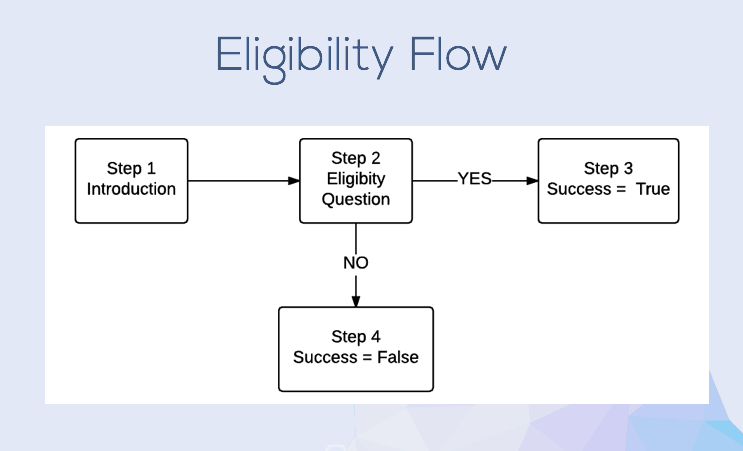
- Create Eligibility Task
- Create Steps (Link to STEPS)
-
- You must include at least 3 steps
- 2 of those steps must be a completion step
- Success
- Failure
- Create Branching Rule (Link to Create Branch Rule)
Create Eligibility Task
For purposes of this guide, we will use the above example to create the eligibility task/steps/branch rule. Steps and Branch Rules will be covered in detail later in this user guide.
Navigation: Axon > Studies > View Study > Create Task > Choose Eligibility Type
The following describes each field available to configure:
*Notes the field is required
| Field | Description | Data Format |
|---|---|---|
| Name* | Name of the Eligibility Task | Short Text |
| Code | Special internal code you can give to your task. It may reference an external system or an IRB Application number | Short Text |
| Description | Description of your task | Long Text |
Create Eligibility Steps
Navigation: Axon > Studies > View Study > View Eligibility Task > Create Step
The following step types will be used to create our eligibility flow
- Instruction Step
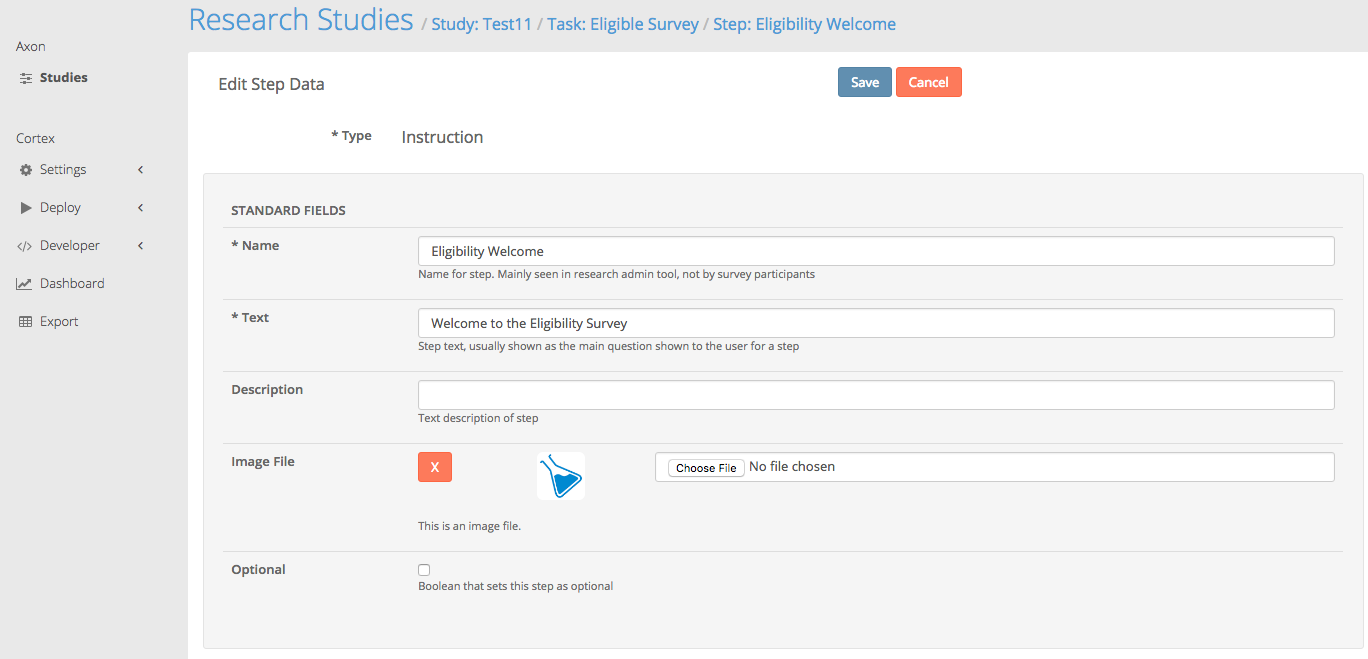
- Boolean Step
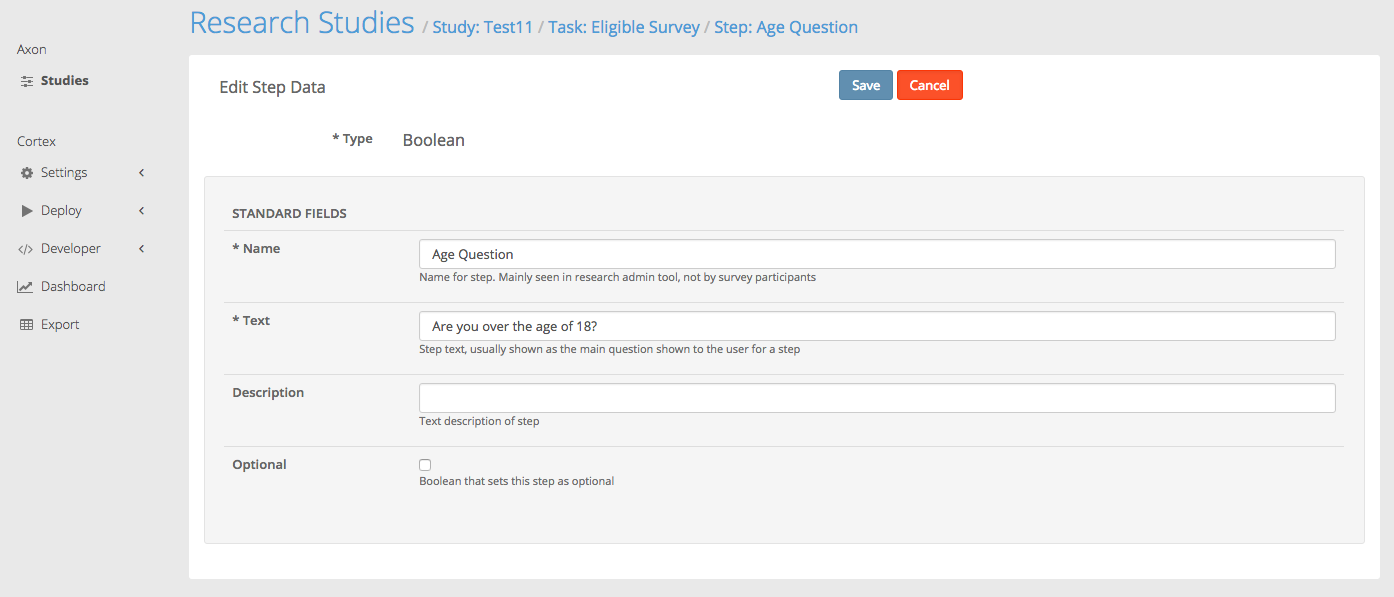
- Completion Step – Success
NOTE: The Success checkbox is Checked
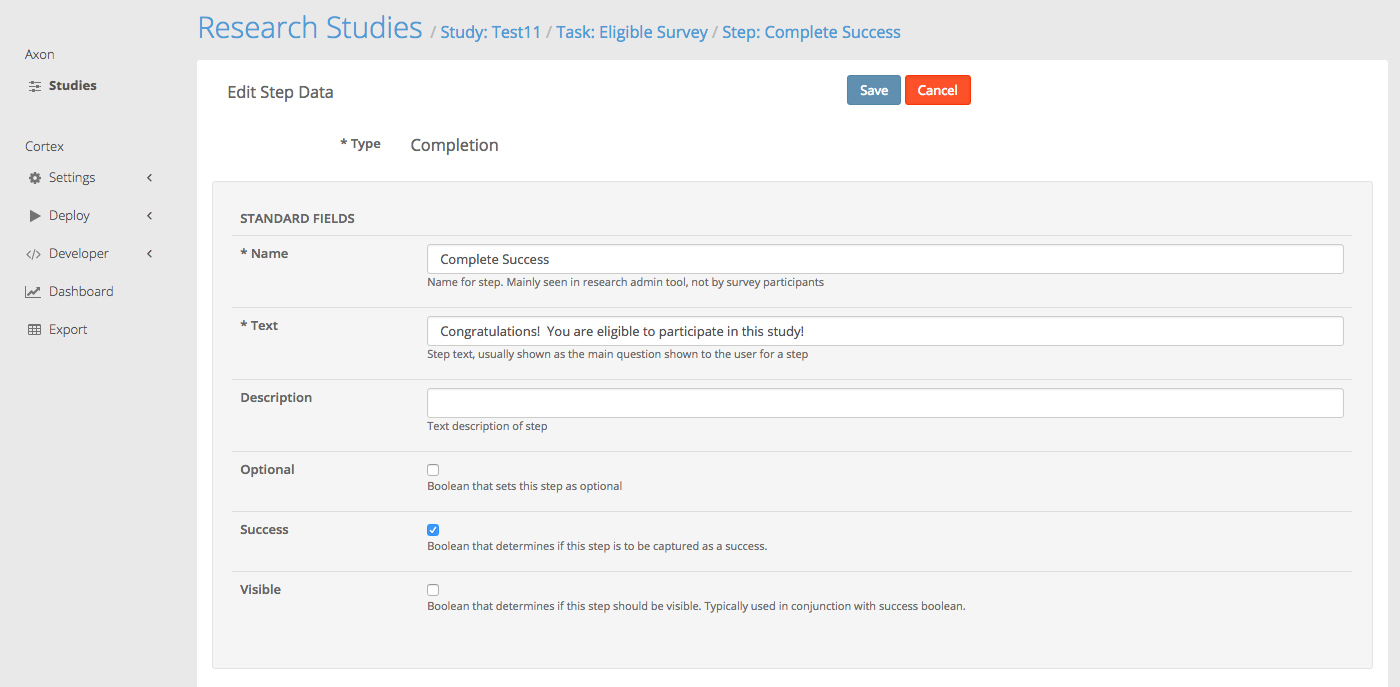
- Completion Step – Fail
NOTE: The Success checkbox is not checked
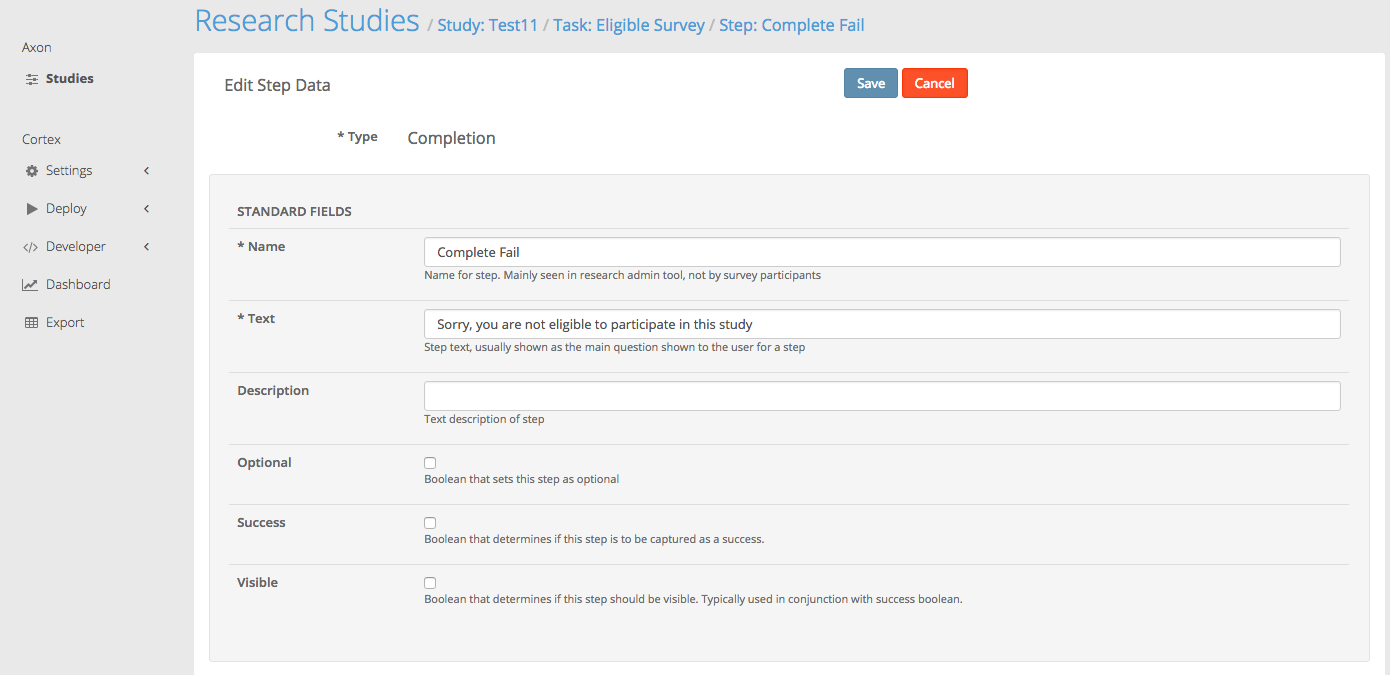
Create Branch Rule
Navigation: Axon > Studies > View Study > View Eligibility Task > Create Branches
The following branch rule will be used to create our eligibility flow
- Branch Rule Header
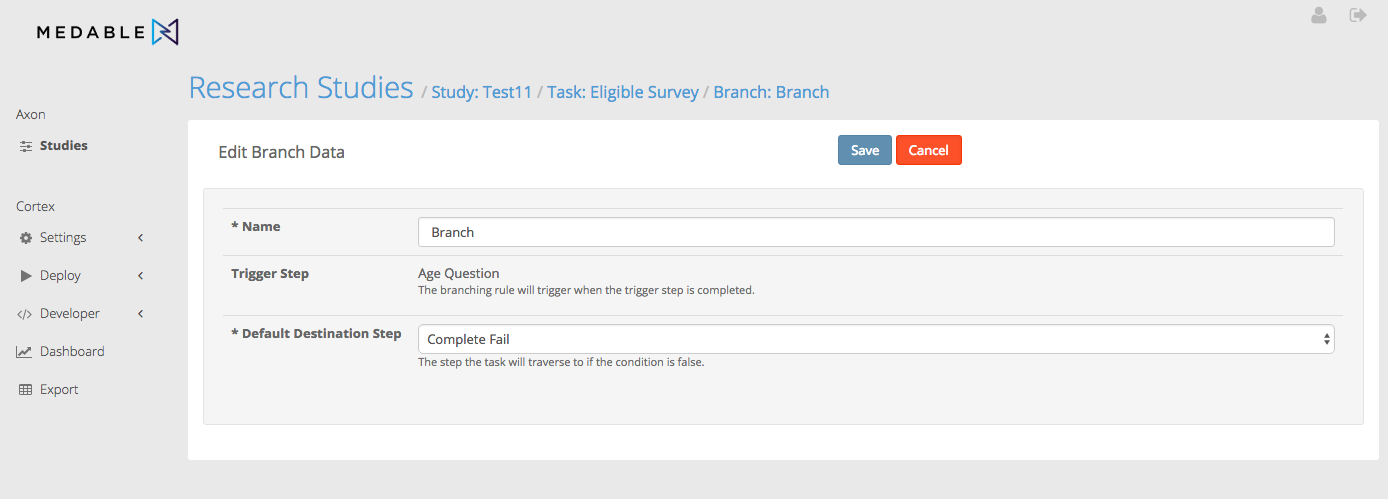
- Branch Rule Condition
Navigation: Axon > Studies > View Study > View Eligibility Task > View Branch Rule > Create Condition
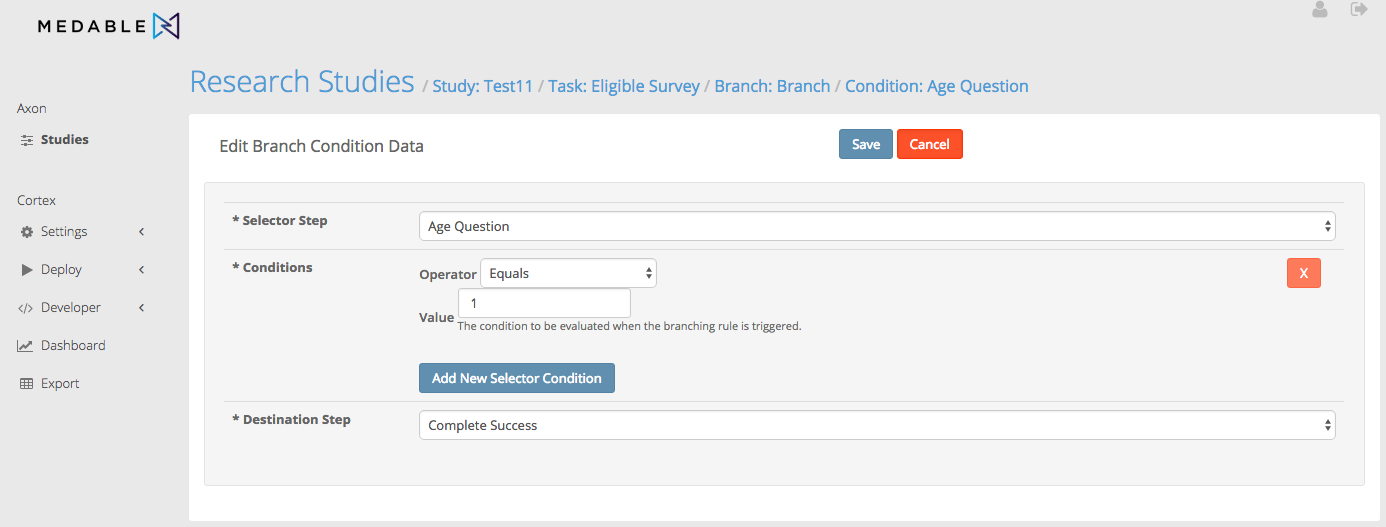
Survey
A survey is composed of a sequence of questions that you use to collect data from your users. To start a survey, you create a survey task, which is a collection of steps. Each step handles a specific question in the survey, such as "What medications are you taking?" or "How many hours did you sleep last night?" Let's begin
TIP: All Survey Tasks must end in a Completion Step to notify the app that the task is complete.
Navigation: Axon > Studies > View Study > Create Task > Choose Survey Type
The following describes each field available to configure:
*Notes the field is required
| Field | Description | Data Format |
|---|---|---|
| Name* | Name of the Survey Task | Short Text |
| Code | Special internal code you can give to your task. It may reference an external system or an IRB Application number | Short Text |
| Description | Description of your task | Long Text |
Authentication
Medable Axon provides an easy to use task for registering users for your study. The task will automatically create a Form Step and the necessary fields to successfully create a participant user in Medable for your study. Let's begin.
Create Authentication Task
Navigation: Axon > Studies > View Study > Create Task > Choose Authentication Type
The following describes each field available to configure:
*Notes the field is required
| Field | Description | Data Format |
|---|---|---|
| Name* | Name of the Authentication Form | Short Text |
| Code | Special internal code you can give to your task. It may reference an external system or an IRB Application number | Short Text |
| Description | Description of your task | Long Text |
Axon will automatically create the Form step with the following steps to capture the fields necessary for a Medable Axon user account. Each step is mapped to a corresponding Account property within Medable.
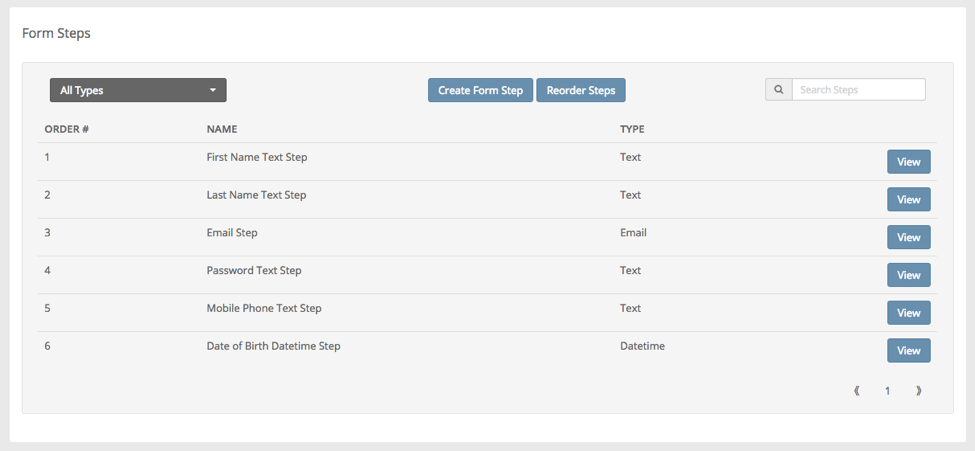
Advanced Authentication Features
What if you wanted to capture more information on registration? You can do that with a few easy steps. Let's Begin.
- Create the Properties on the Account object that you want to capture. You can find a tutorial in the Medable Cortex documentation.
- Create the additional form steps that you want to capture and assign the mapping field to the Account Property.
TipThe Account Mapping field only exists on Steps and Form Steps where the parent task is of type Authentication.
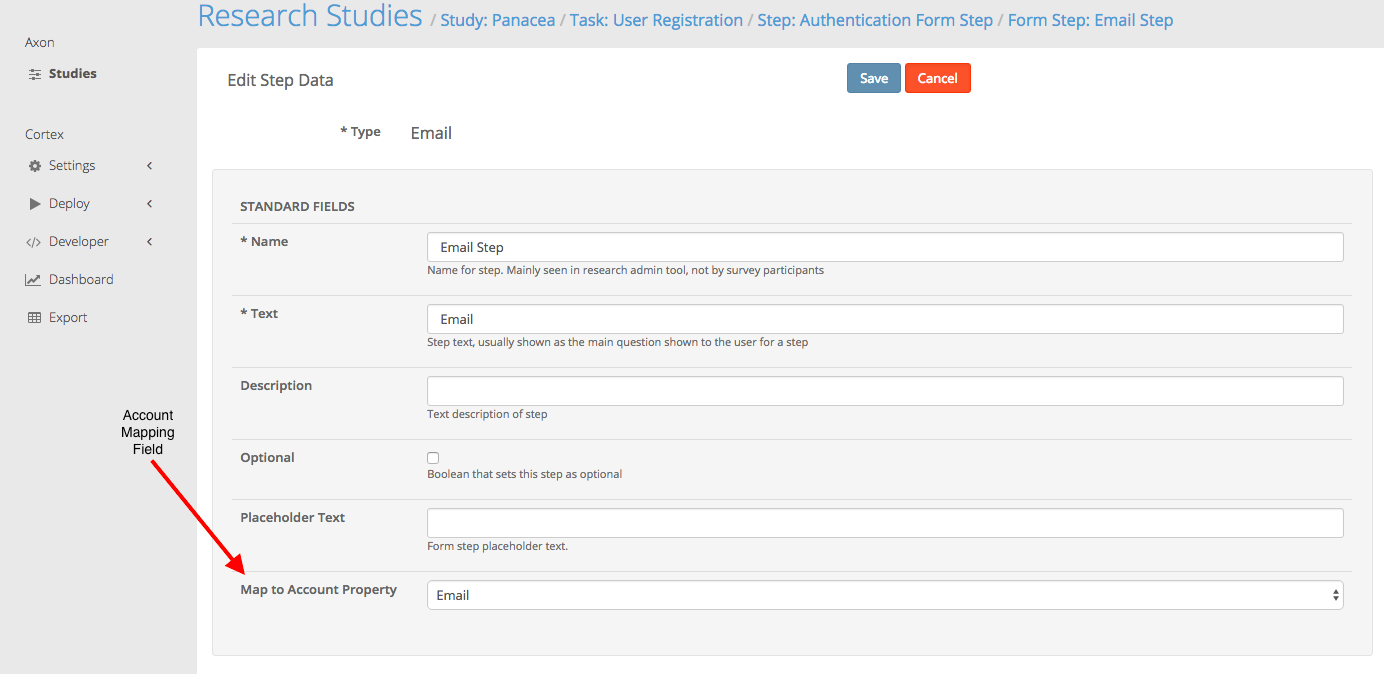
- No need to add a completion step for an Authentication Task, just hit save and test. Upon registration, Medable Axon will store the information gathered on the user Account.
Active Tasks
Some studies may need more data than is provided by responses to survey questions or the data collection capabilities of the HealthKit and CoreMotion APIs on iOS. Active tasks invite users to perform activities under partially controlled conditions using iPhone sensors to actively collect data. For example, an active task for analyzing gait and balance might asks the user to walk a short distance, while collecting accelerometer data on the device. Axon supports the following Active Tasks:
Audio
In the audio task, the user makes a sustained sound, and an audio recording is made. Analysis of the audio data is not included in the ResearchKit framework, but might naturally involve looking at the power spectrum and how it relates to the ability to produce certain sounds. The ResearchKit framework uses the AVFoundation framework to collect this data and to present volume indication during recording. No data analysis is done by ResearchKit; you can define your analysis on this task according to your own requirements.
Create Audio Task
Navigation: Axon > Studies > View Study > Create Task > Choose Predefined Active Task > Choose Audio
The following describes each field available to configure:
*Notes the field is required
Field | Description | Data Format |
|---|---|---|
Name * | Name of the Audio Task | Short Text |
Code Name | Special internal code you can give to your task. It may reference an external system or an IRB Application number | Short Text |
Description | Description of your task | Long Text |
Intended Use | Instructional content describing the intended use of the data collected. If left blank, default localized text is used. | Short Text |
Speech Instruction | Instructional content describing what the user needs to do when recording begins. If left blank, the default localized text is used | Short Text |
Short Speech Instruction | Instructional content shown during audio recording. If left blank, the default localized text is used | Short Text |
Duration * | The amount of seconds the count down timer runs for while audio data is collected. Minimum 5 seconds | Number |
Record Setting * |
| Short Text |
The screenshots below show an example of an audio task.
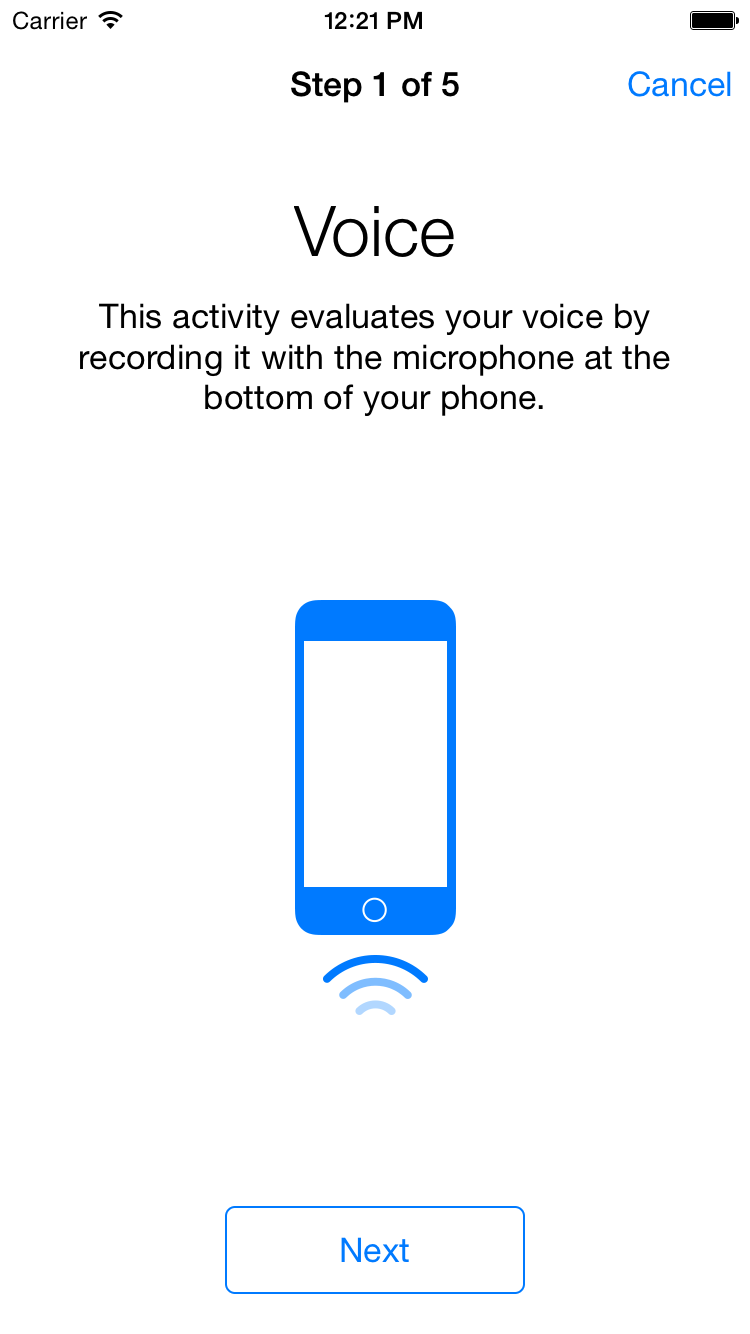
Instruction Step
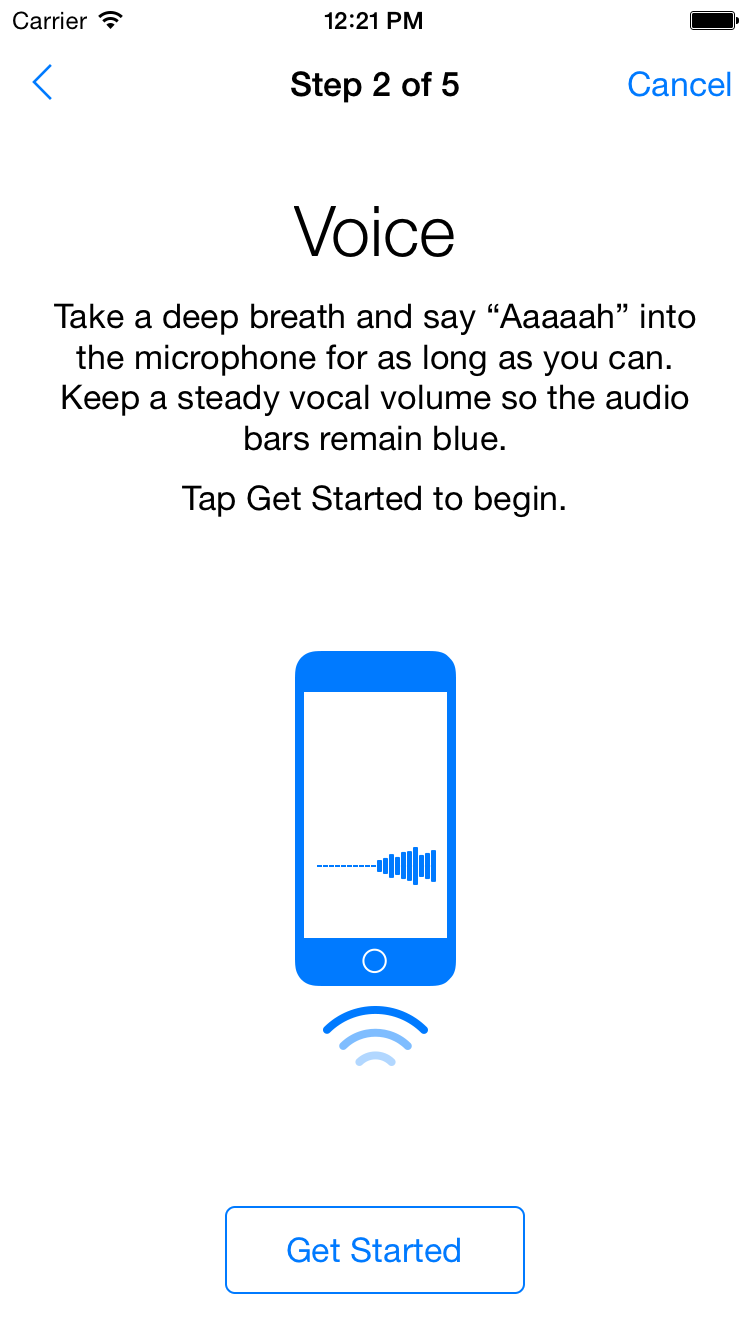
Instruction Step
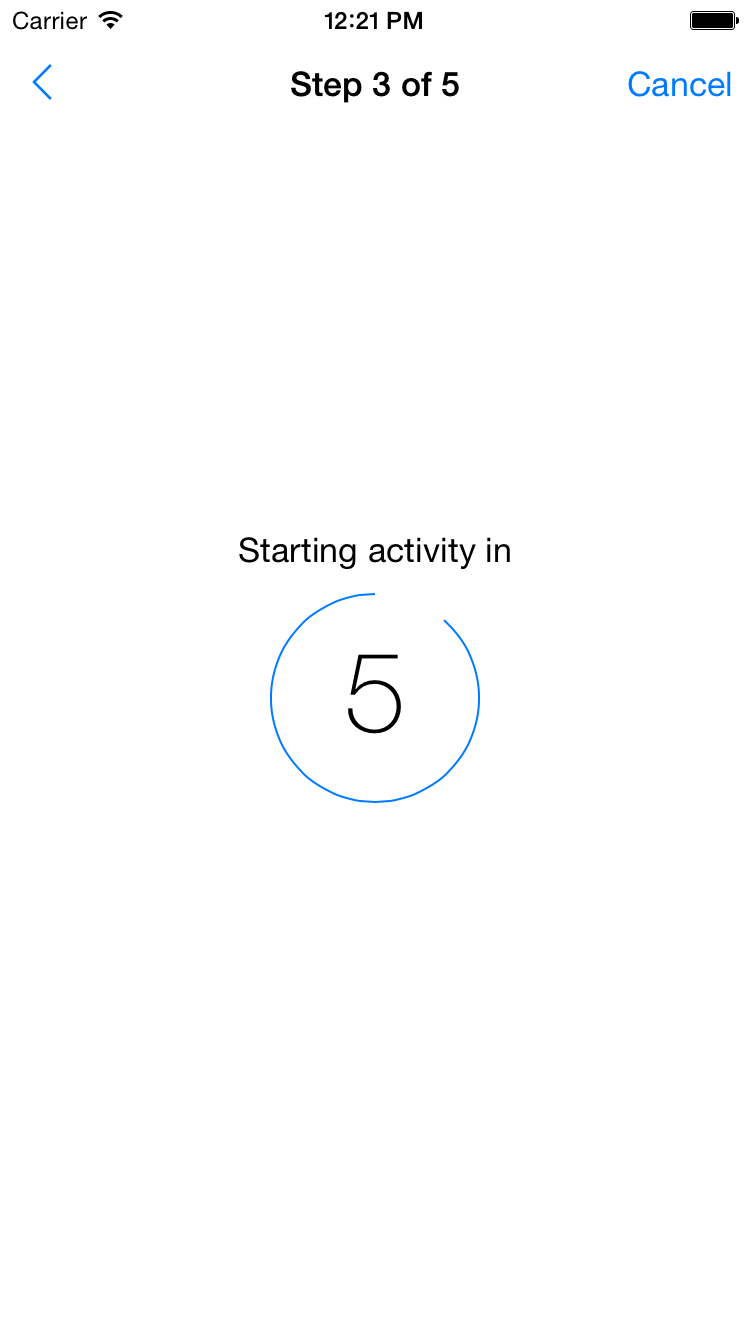
Count Down
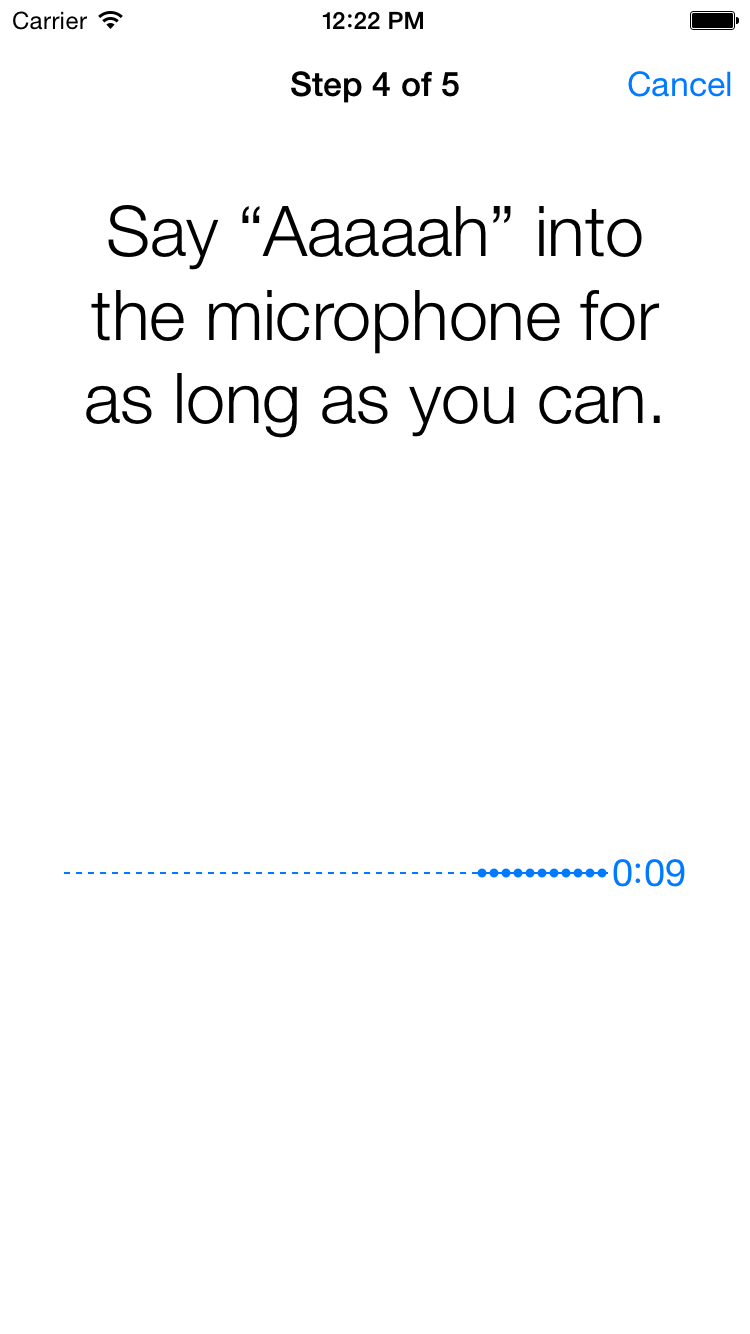
Audio Collection Step
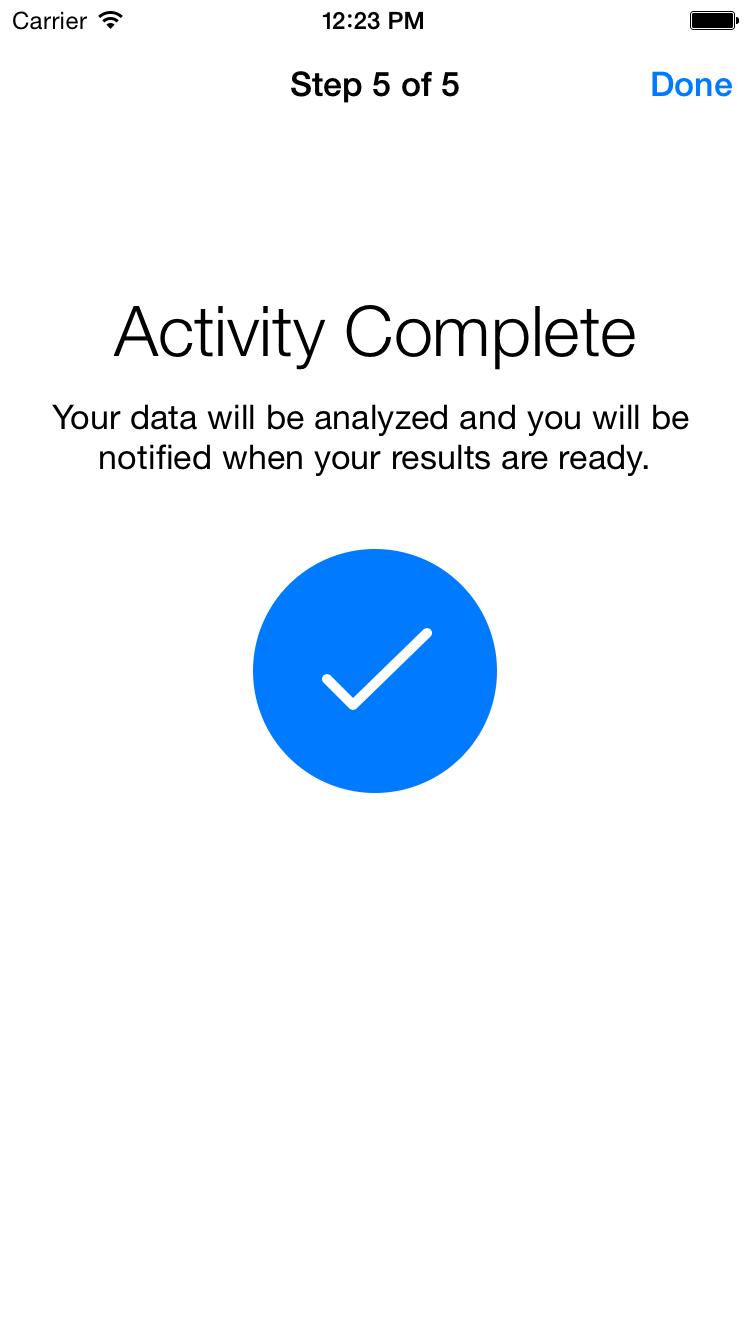
Completion Step
Fitness Check
In the fitness task, the user walks for a specified duration (usually several minutes). Sensor data is collected and returned. Sensor data can include accelerometer, device motion, pedometer, location, and heart rate data where available.
Toward the end of the walk, if heart rate data is available, the user is asked to sit down and rest for a period. Data collection continues during the rest period.
Create Fitness Check Task
Navigation: Axon > Studies > View Study > Create Task > Choose Predefined Active Task > Choose Fitness Check
The following describes each field available to configure:
*Notes the field is required
| Field | Description | Data Format |
|---|---|---|
| Name* | Name of the Fitness Check Task | Short Text |
| Code Name | Special internal code you can give to your task. It may reference an external system or an IRB Application number | Short Text |
| Description | Description of your task | Long Text |
| Intended Use | Instructional content describing the intended use of the data collected. If left blank, default localized text is used. | Short Text |
| Walk Duration* | The duration of the walk in seconds. Maximum is 600 seconds | Number |
| Rest Duration* | The duration of the post walk rest period in seconds | Number |
The screenshots below show how a fitness task might look.
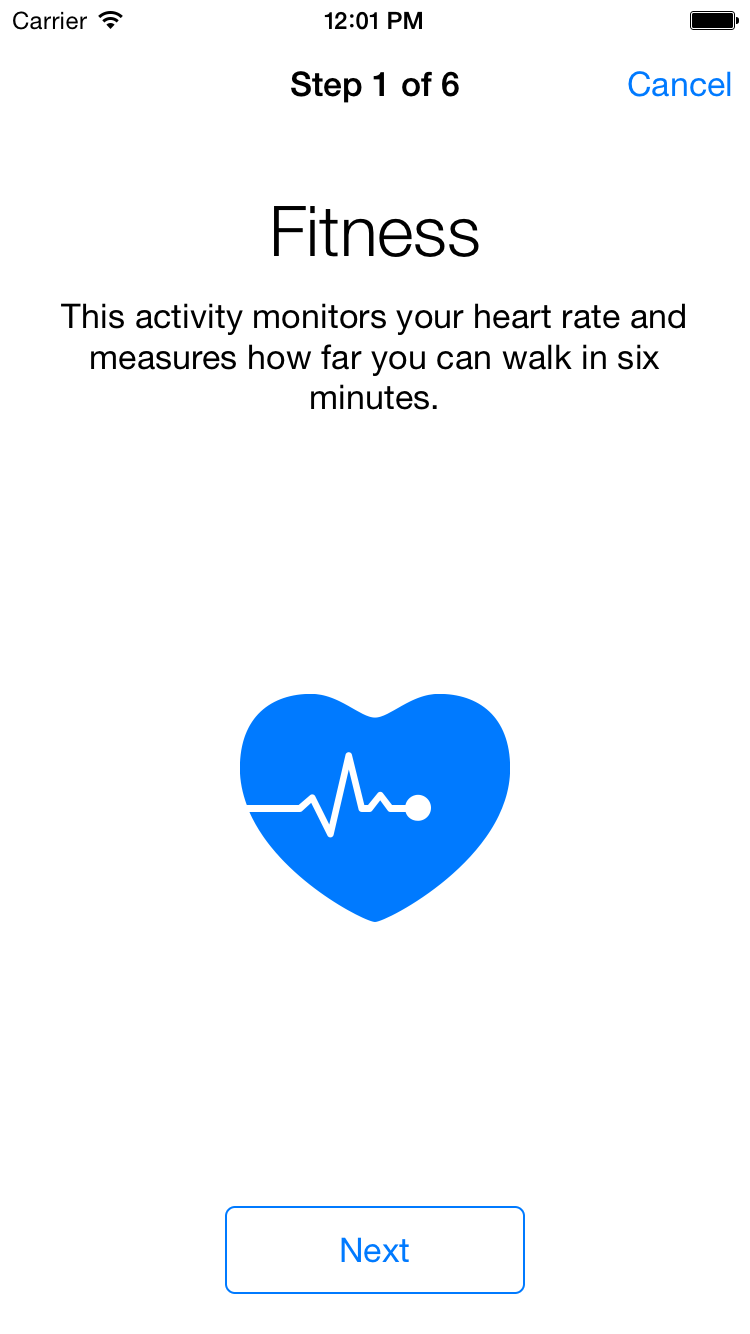
Instruction Step
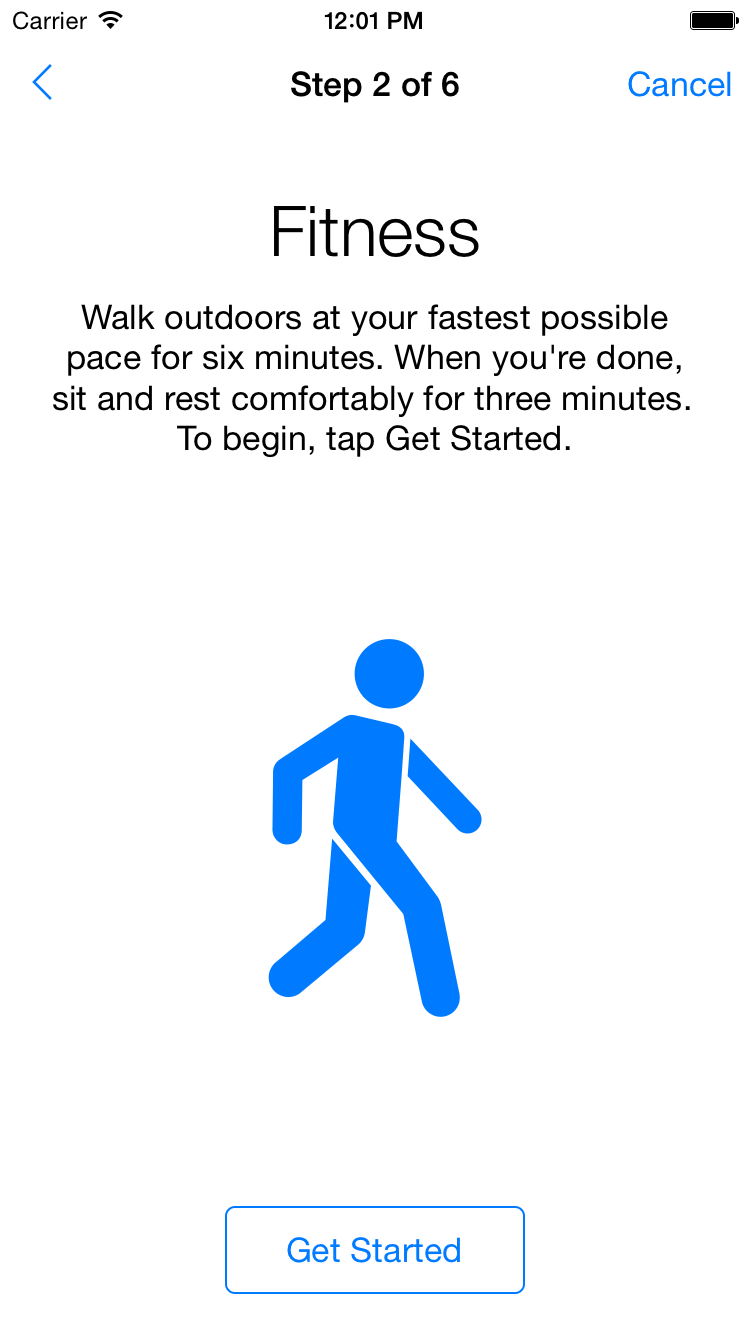
Instruction Step
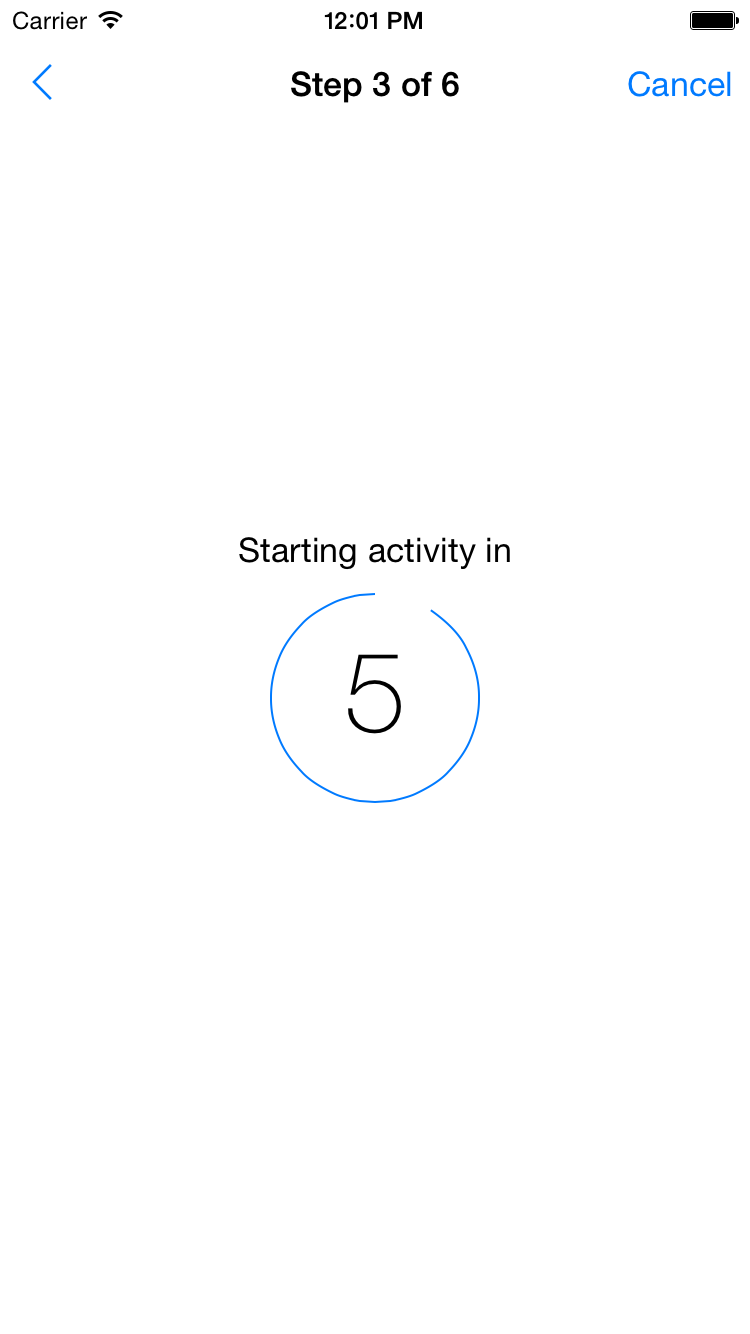
Count Down
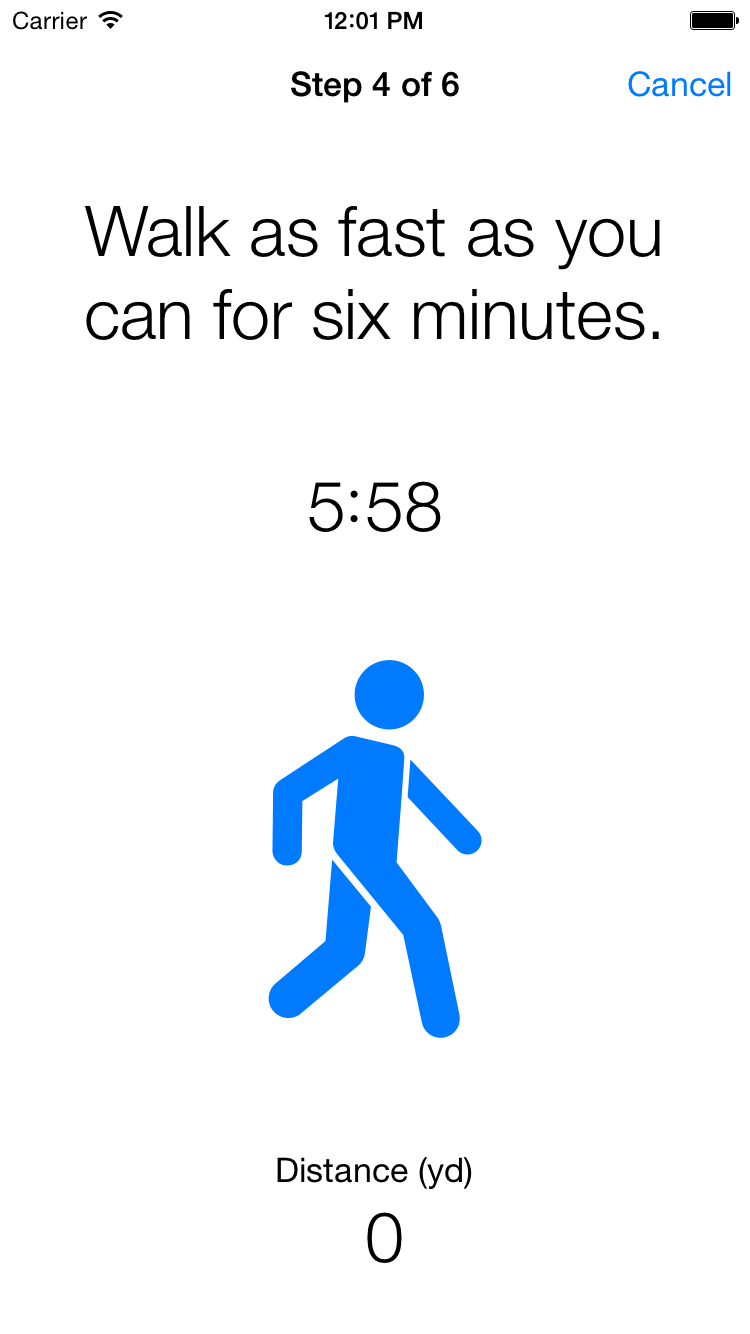
Distance and Heart Rate Collection Step
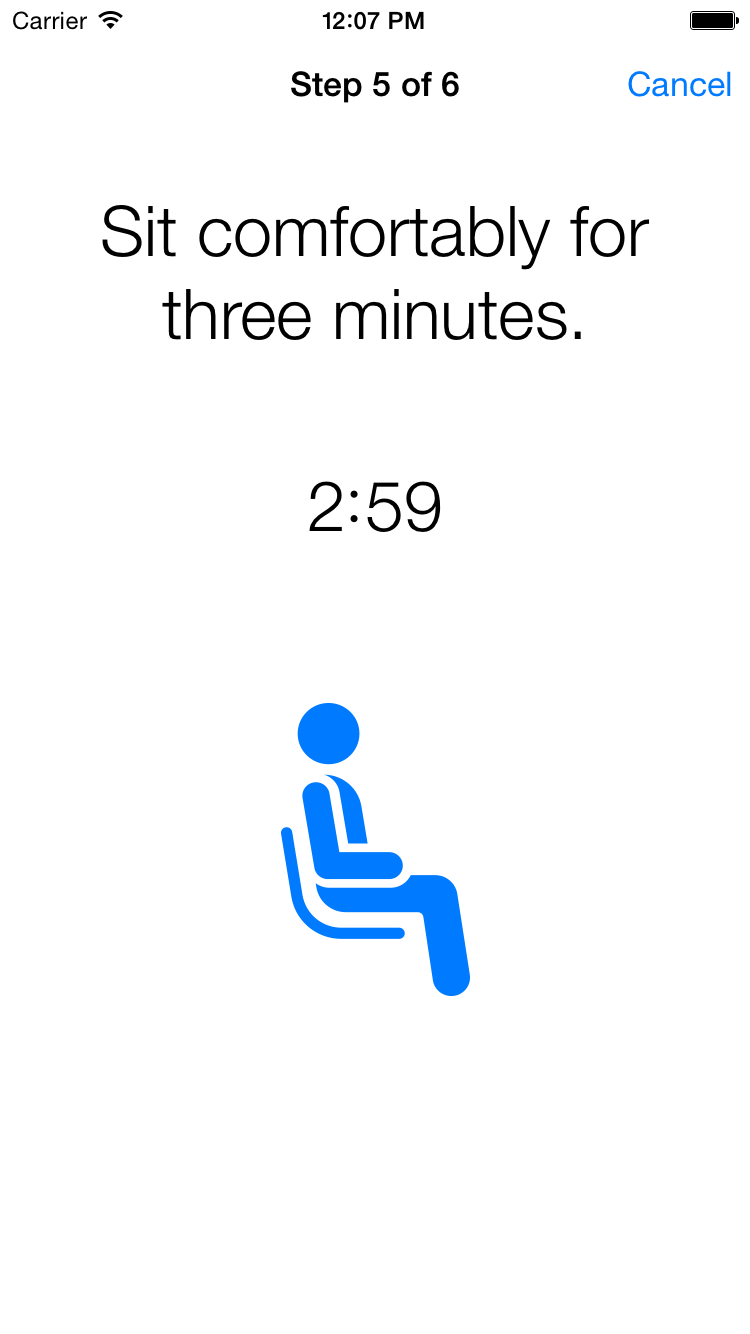
Rest Step
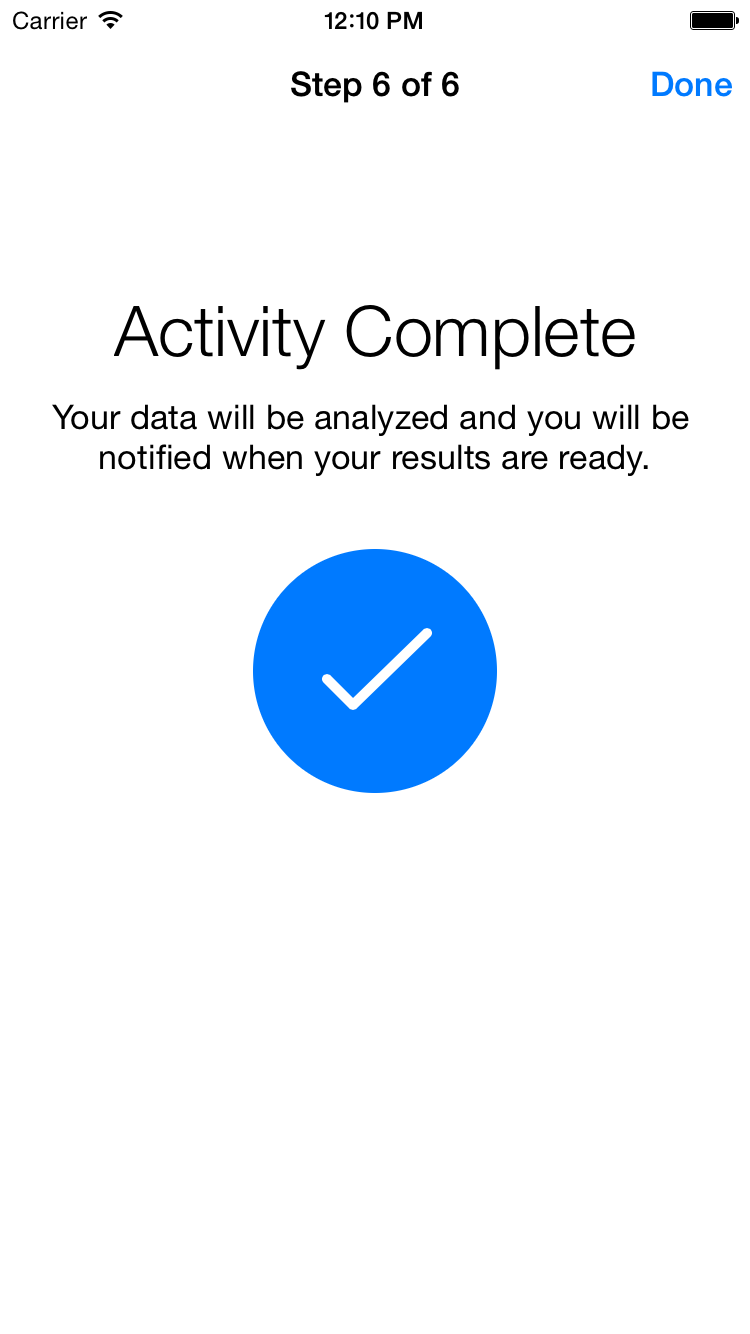
Completion Step
Short Walk
In the short walk task (also known as a gait and balance task), the user walks for a short distance, which may be indoors. You might use this semi-controlled task to collect objective measurements that can be used to estimate stride length, smoothness, sway, and other aspects of the participant’s walking.
The presentation of the short walk task differs from the fitness check task in that the distance is replaced by the number of steps taken, and the walk is split into a series of legs. After each leg, the user is asked to turn and reverse direction.
The data collected by this task can include accelerometer, device motion, and pedometer data.
Create Short Walk Task
Navigation: Axon > Studies > View Study > Create Task > Choose Predefined Active Task > Choose Fitness Check
*Notes the field is required
| Field | Description | Data Format |
|---|---|---|
| Name* | Name of the Short Walk Task | Short Text |
| Code Name | Special internal code you can give to your task. It may reference an external system or an IRB Application number | Short Text |
| Description | Description of your task | Long Text |
| Intended Use | Instructional content describing the intended use of the data collected. If left blank, default localized text is used. | Short Text |
| Walk Duration* | The duration of the walk in seconds. Maximum is 600 seconds | Number |
| Rest Duration* | The duration of the post walk rest period in seconds | Number |
The screenshots below show an example of a short walk task.
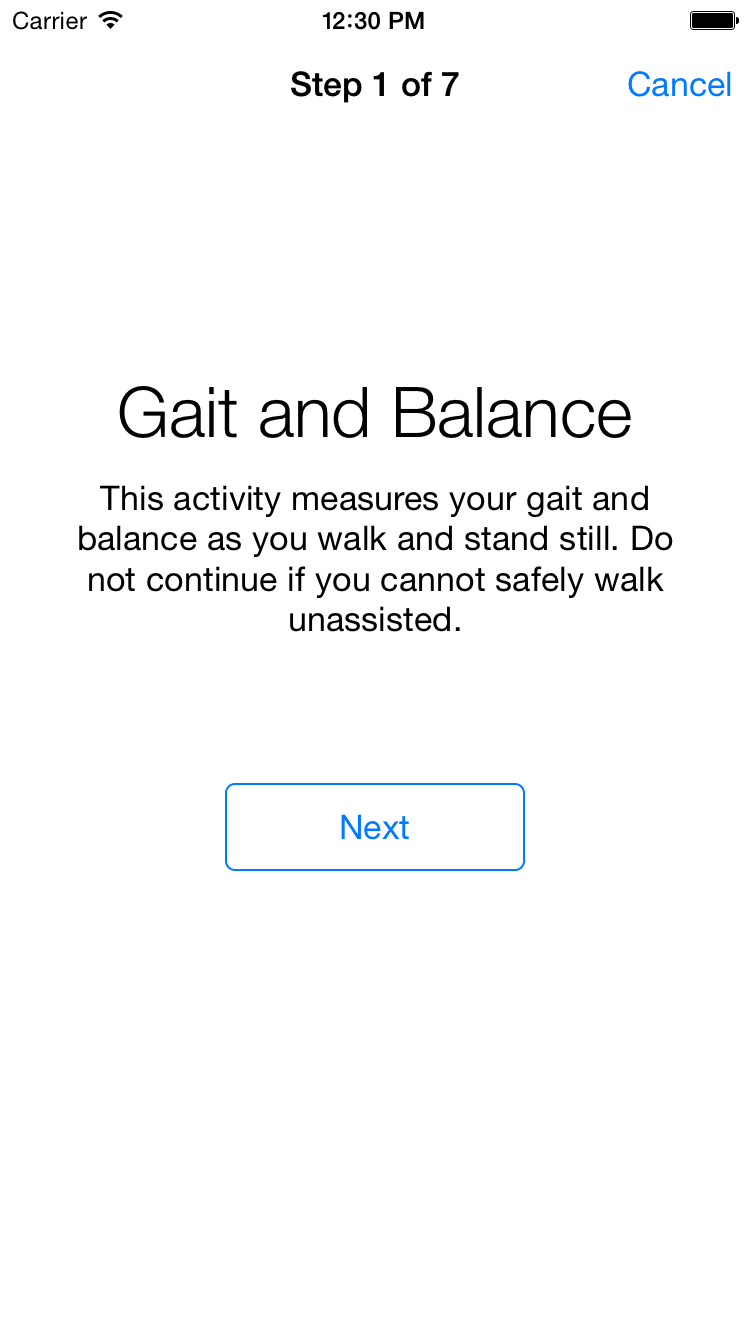
Instruction Step
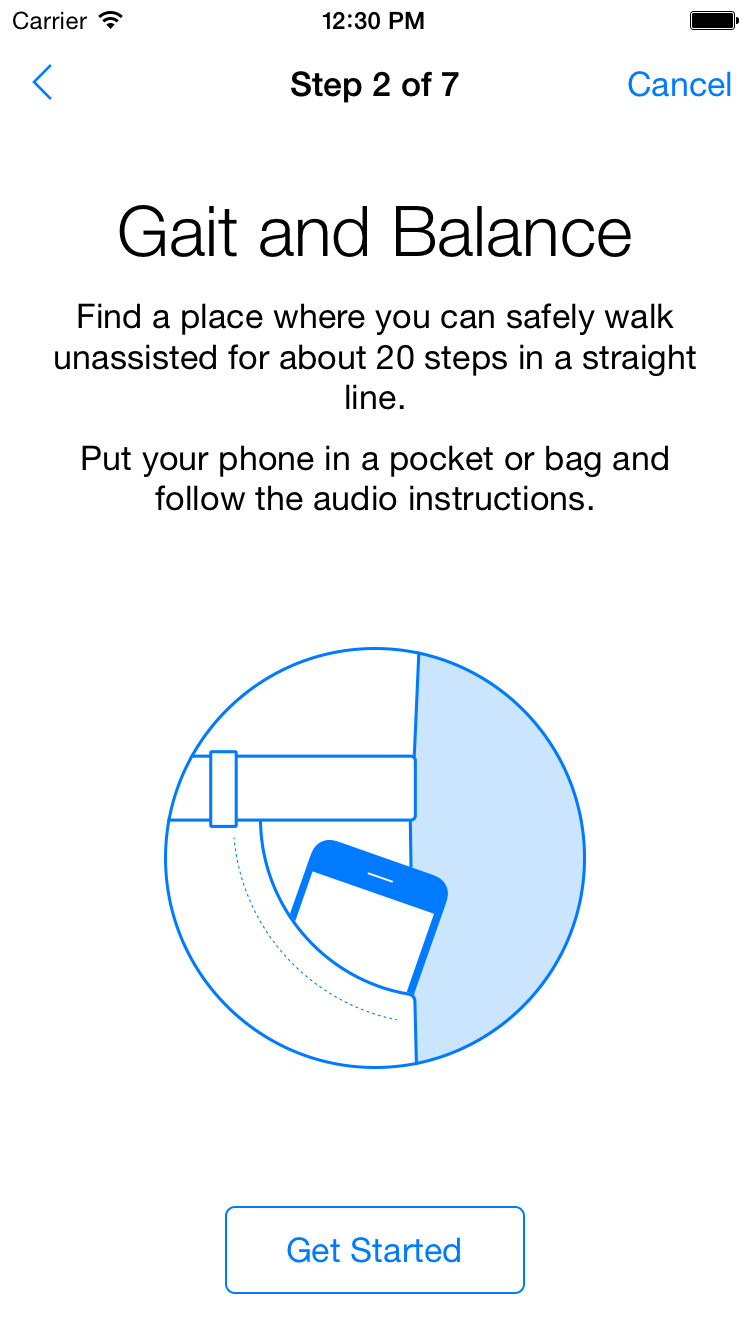
Instruction Step
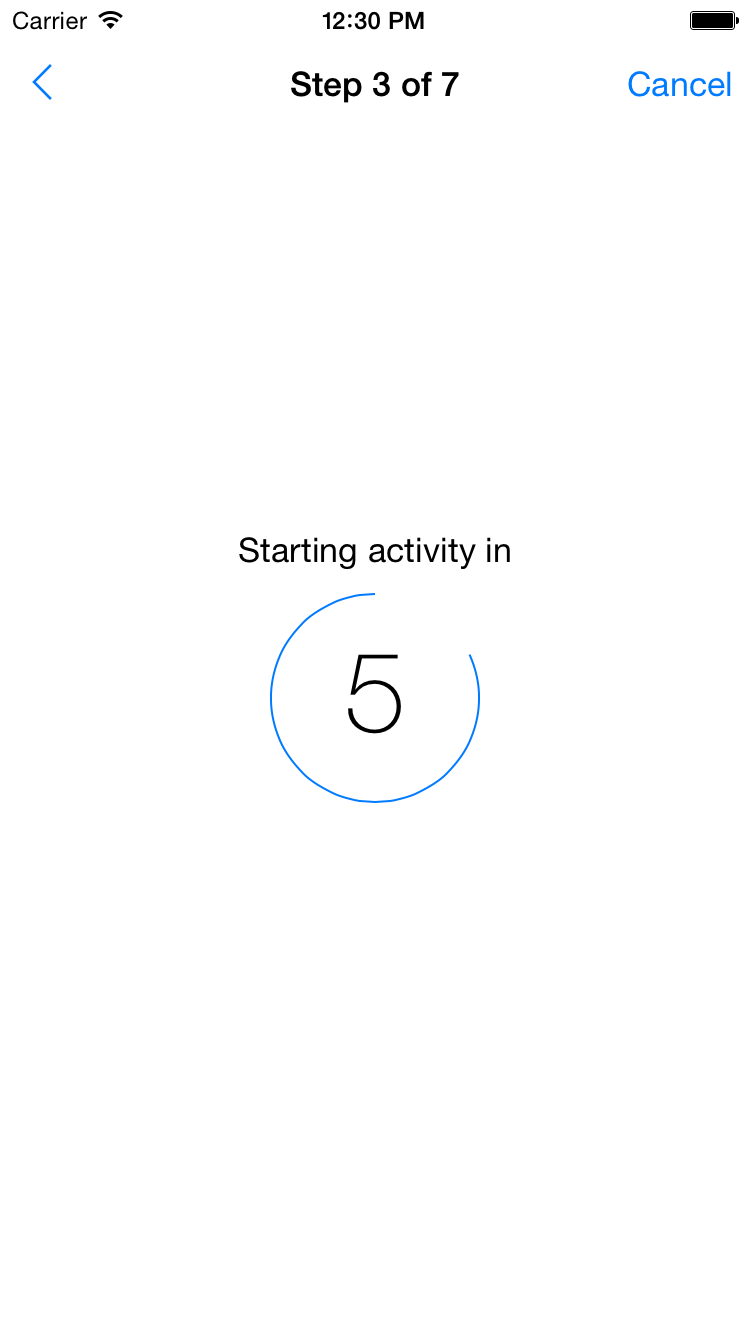
Countdown
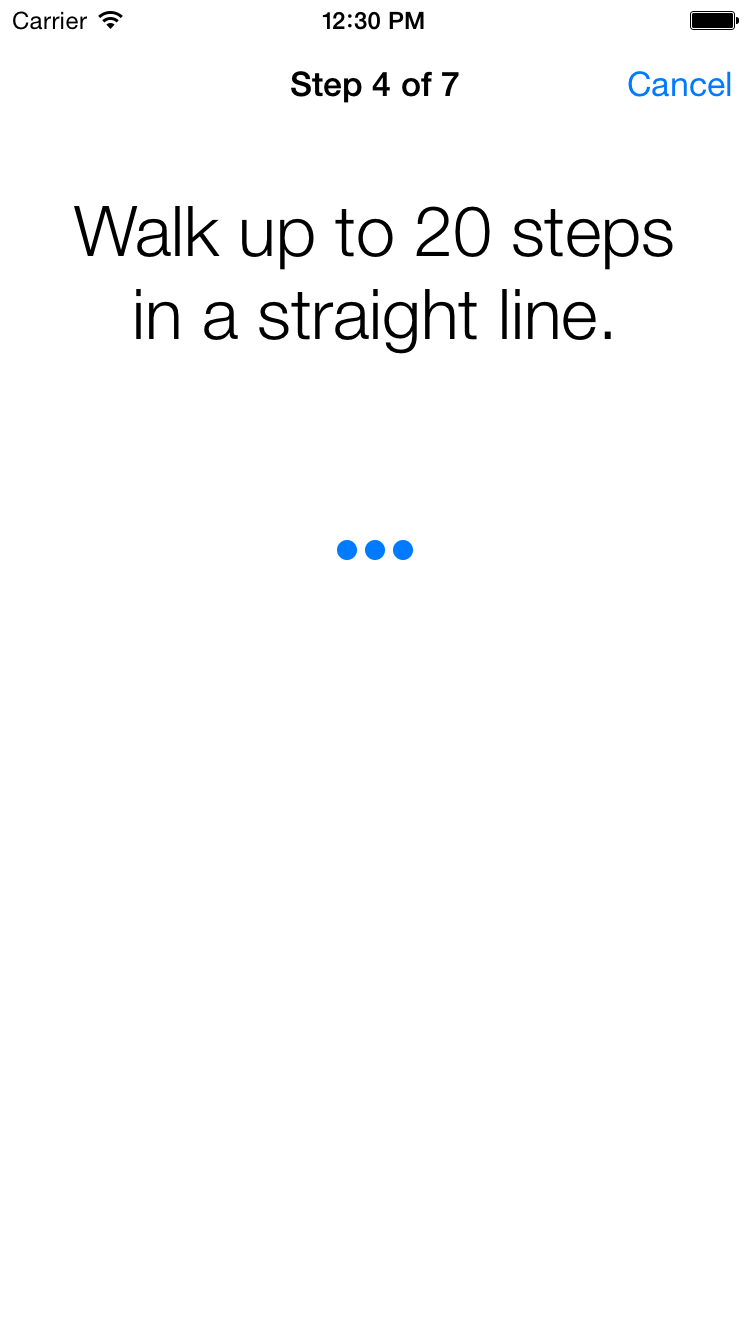
Asking user to walk
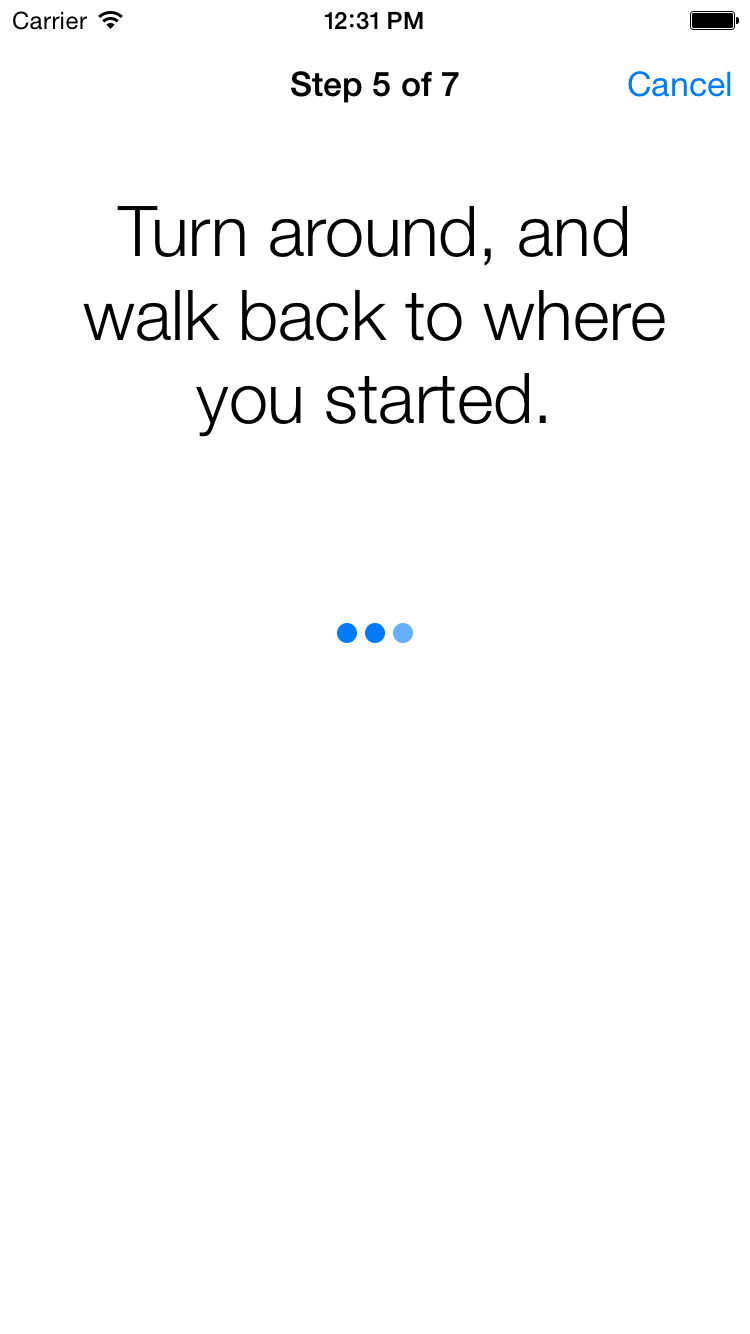
Asking user to walk
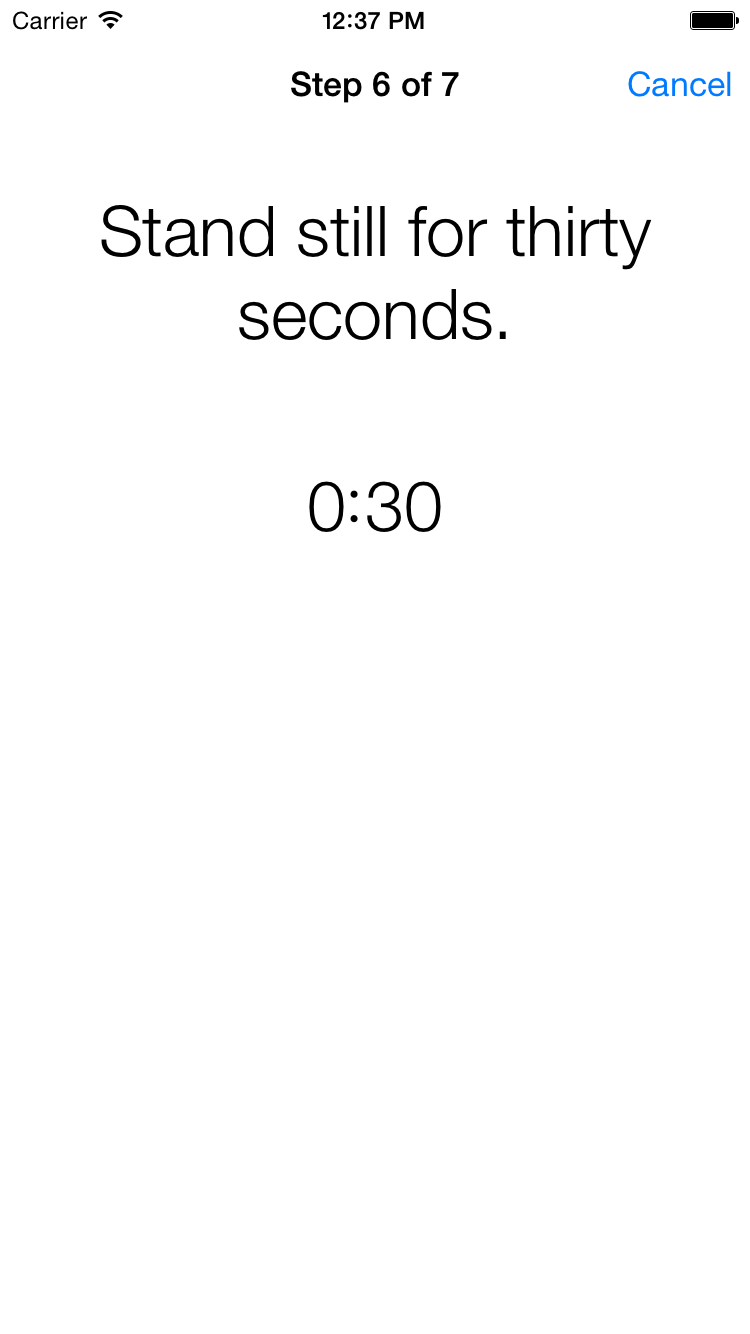
Asking user to rest
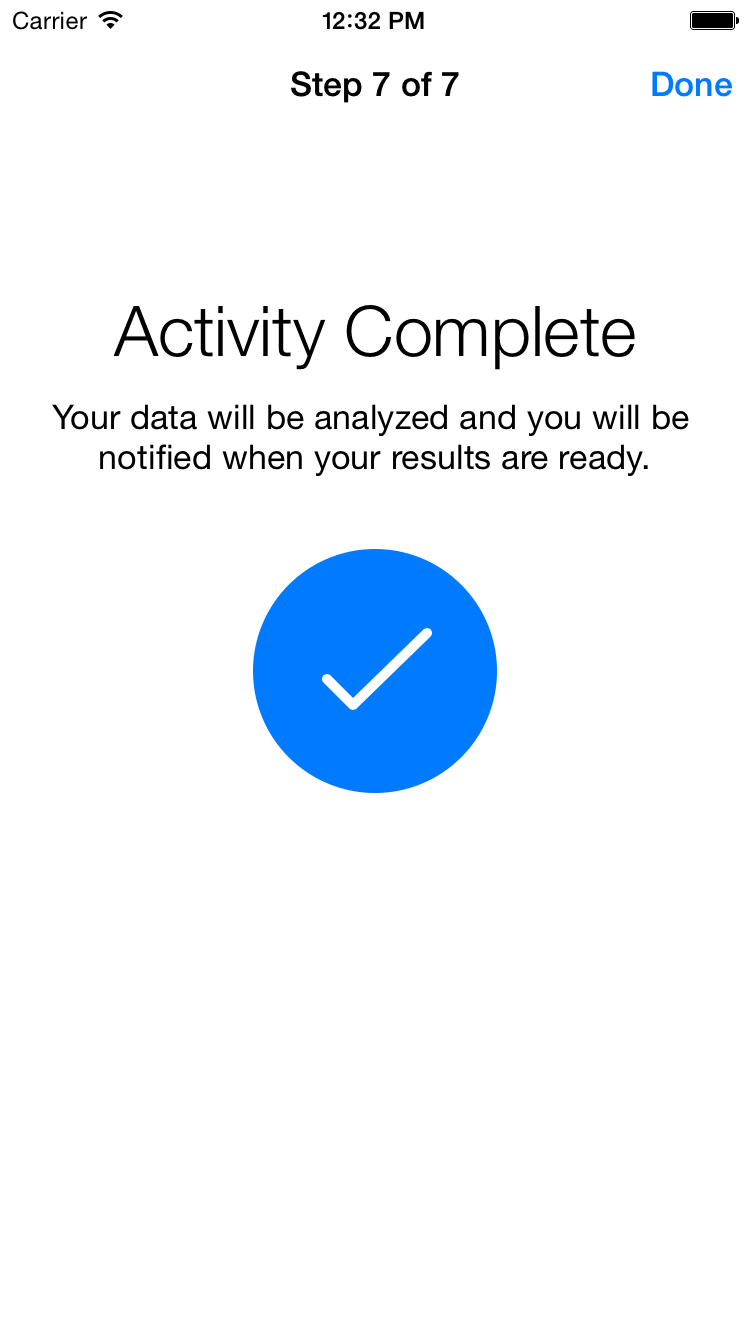
Completion Step
9-Hole Peg Test
The 9-hole peg test is a two step test of hand dexterity to measure the MSFC score in Multiple Sclerosis, Parkinson’s disease, or stroke.
Practically speaking, this task generates a two step test in which the participant must put a variable number of pegs in a hole (the place step), and then remove them (the remove step). This task tests both hands.
The data collected by this task includes the number of pegs, an array of move samples, and the total duration that the user spent taking the test.
Create 9-Hole Peg Test Task
Navigation: Axon > Studies > View Study > Create Task > Choose Predefined Active Task > Choose Peg in Hole
*Notes the field is required
| Field | Description | Data Format |
|---|---|---|
| Name* | Name of the Peg in Hole Task | Short Text |
| Code Name | Special internal code you can give to your task. It may reference an external system or an IRB Application number | Short Text |
| Description | Description of your task | Long Text |
| Dominant Left | The participant dominant hand that will be tested first. Checked means the left hand is first, unchecked means the right hand is first. | Checkbox |
| Number of Pegs* | The number of pegs to place in the pegboard. Number of pegs must be greater than or equal to 1 | Number |
| Time Limit | The duration allowed to validate the peg position. Duration can not be shorter than 1 seconds | Number |
| Threshold* | The threshold value used for the detection area. Must be greater than or equal to 0 and lower or equal to 1 | Number/Decimal |
| Rotated | Checking this will enable a test variant that also requires peg rotation | Checkbox |
The screenshots below show an example of both place and remove tasks.
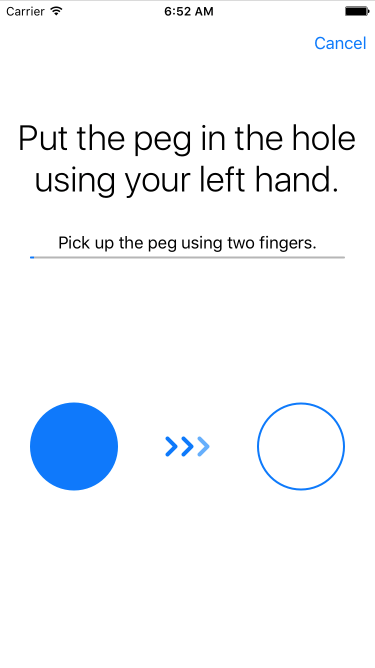
The peg place task
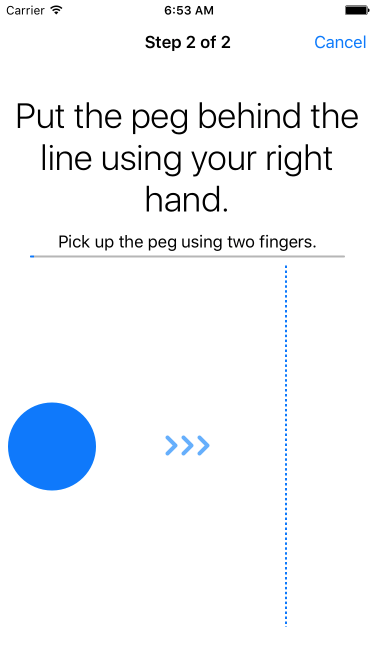
The peg remove step
Tower of Hanoi
In the Tower of Hanoi task, the user is asked to solve the classic Tower of Hanoi puzzle in a minimum number of moves. To solve the puzzle, the user must move the entire stack to the highlighted platform in as few moves as possible. This task measures the user’s problem solving skills. A Tower of Hanoi task finishes when the user completes the puzzle correctly or concedes that they cannot solve the puzzle.
Data collected in this task consists of how many moves were taken and whether the puzzle was successfully completed or not.
Create Tower of Hanoi
Navigation: Axon > Studies > View Study > Create Task > Choose Predefined Active Task > Choose Fitness Check
*Notes the field is required
| Field | Description | Data Format |
|---|---|---|
| Name* | Name of the Tower of Hanoi Task | Short Text |
| Code Name | Special internal code you can give to your task. It may reference an external system or an IRB Application number | Short Text |
| Description | Description of your task | Long Text |
| Number of Disks* | The number of disks in the puzzle; the default value for this property is 3 | Number |
The screenshots below show an example of a Tower of Hanoi task.
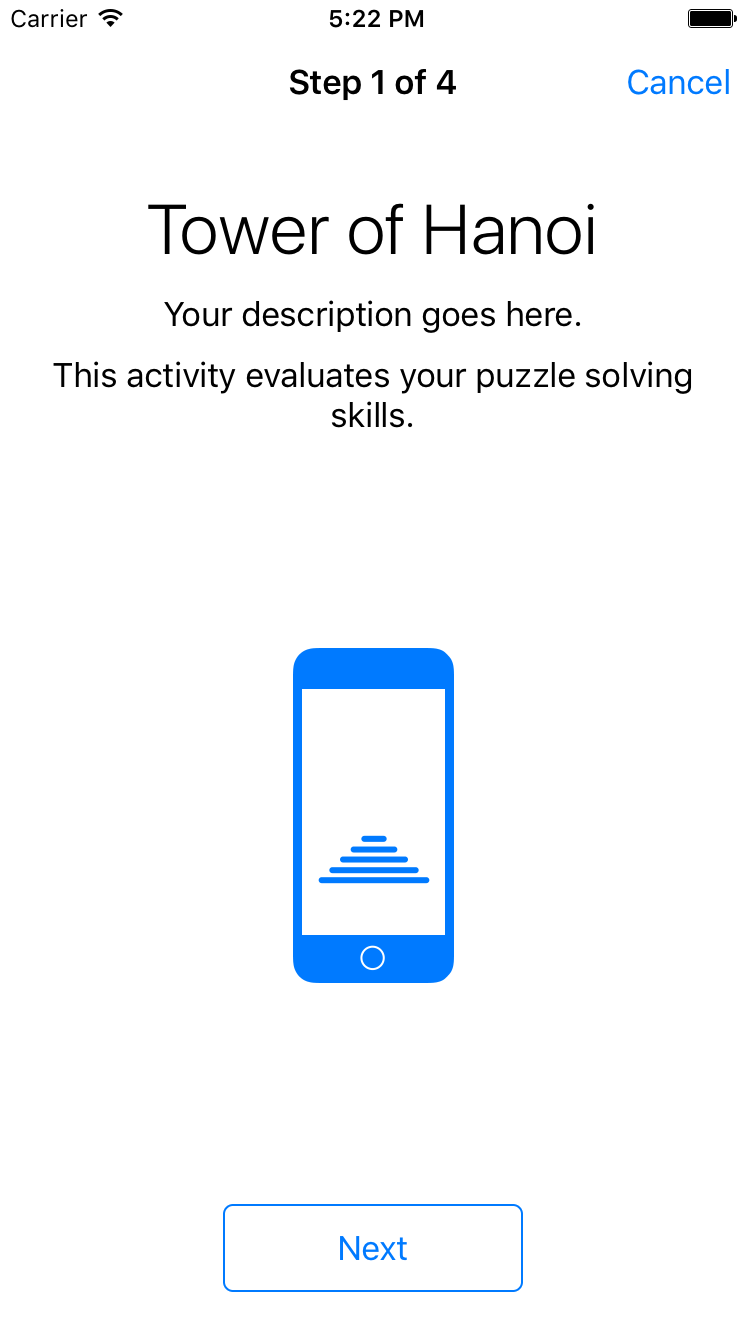
Instruction Step
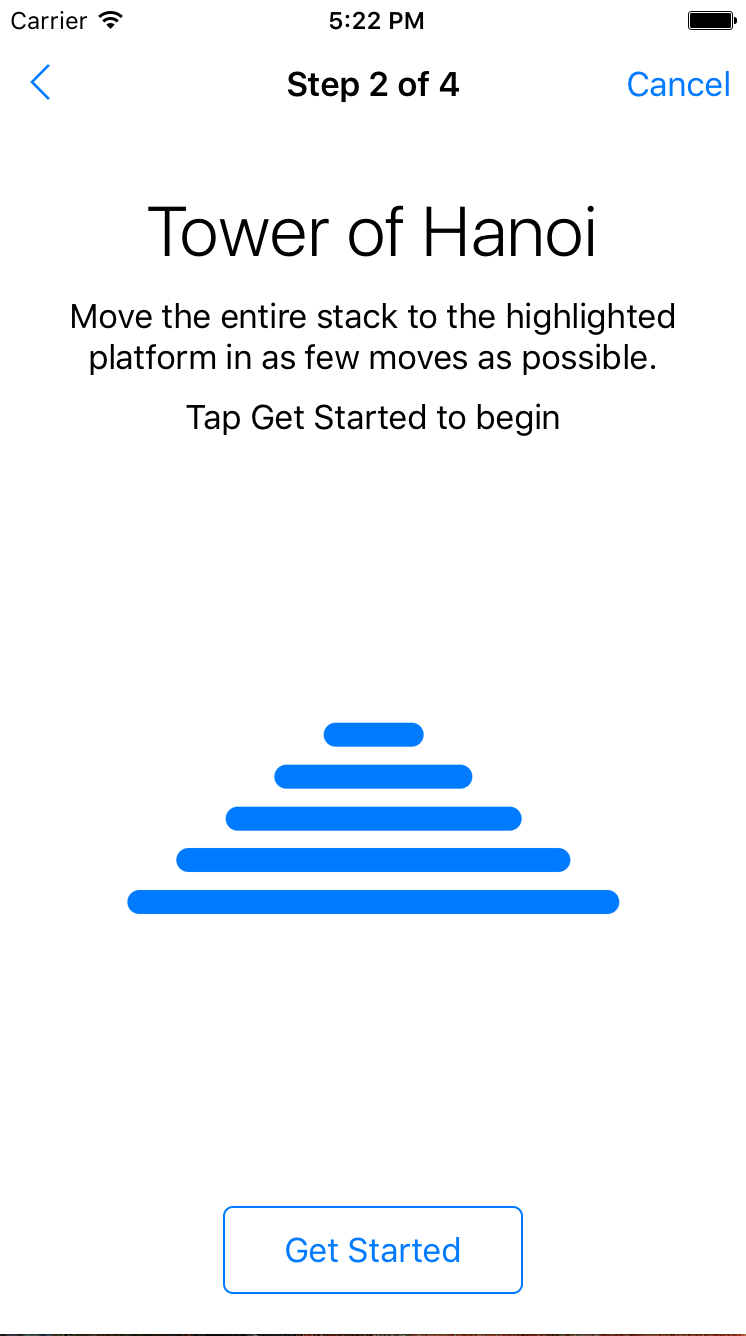
Instruction Step
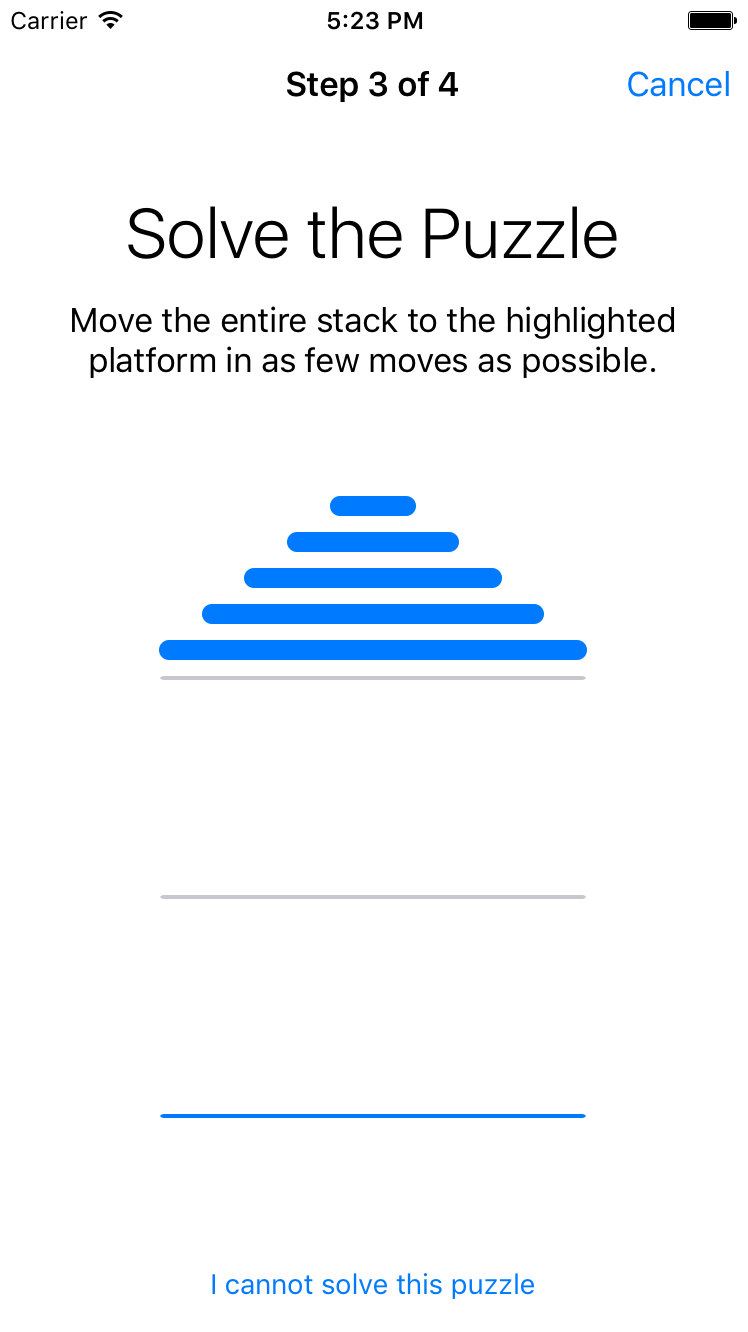
Actual Task
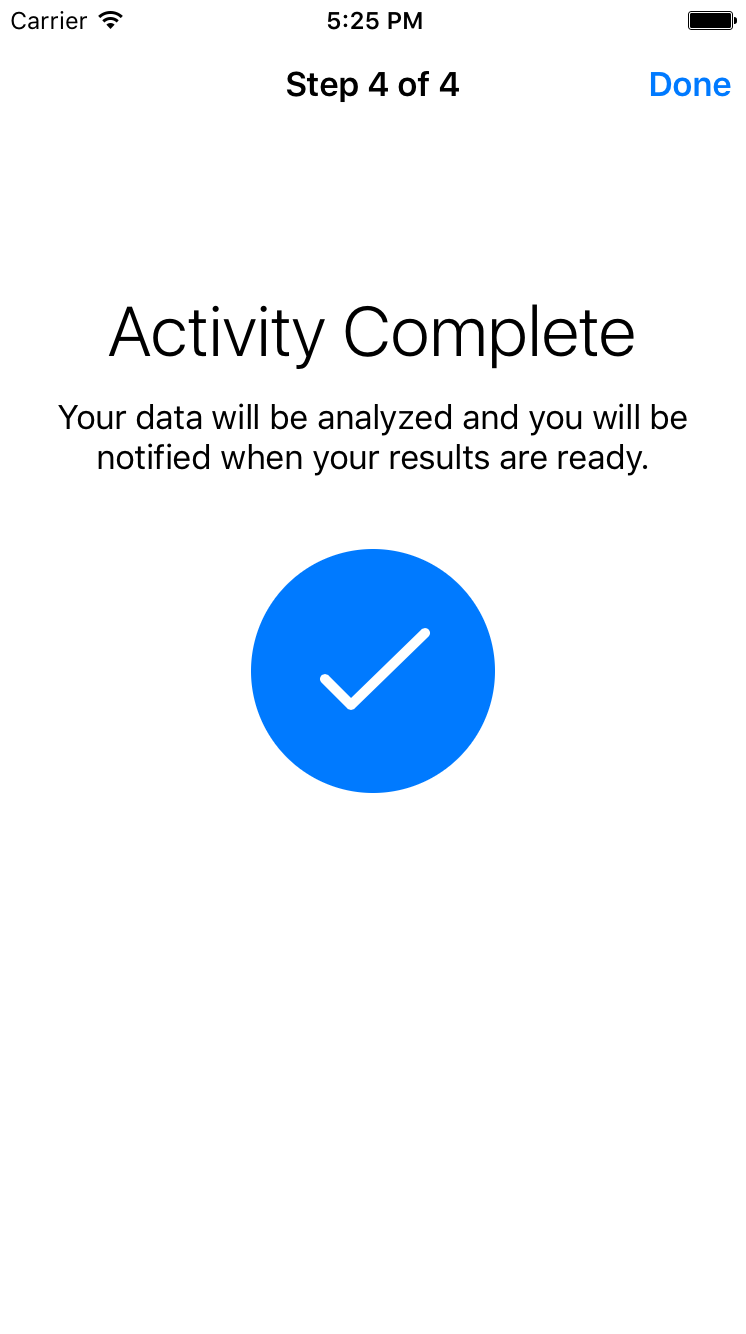
Completion Step
Updated 4 months ago